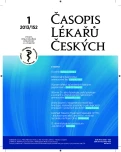Significance of human papillomavirusinfections
Authors:
Daniel Driák; Borek Sehnal
Authors place of work:
Gynekologicko-porodnická klinika 1. LF UK a Nemocnice Na Bulovce, Praha
Published in the journal:
Čas. Lék. čes. 2013; 152: 15-19
Category:
Přehledový článek
Summary
Human papillomavirus is one of the most frequent sexually transmitted diseases; more than three quarters of sexually active population are infected during their lifetime. Most of papillomavirus infections clear spontaneously, however persistent high-risk human papillomavirus 16 and 18 are responsible for over 70% of all cases of cervical cancer and related to a major part of cancers in the vulva, vagina, penis, anal region, and oropharynx. It is estimated that approximately 5.2% of all cancers are associated with oncogenic human papillomavirus infection.
Keywords:
human papillomavirus – cervical cancer – vulvar cancer – vaginal cancer – penile cancer – oropharyngeal cancer – esophageal cancer – genital warts – laryngeal papillomatosis
Zdroje
1. Hamšíková E, et al. Infekce HPV – epidemiologické a klinické souvislosti. Farmakoter rev 2007; 4–6.
2. Sláma J. Možnosti prevence a principy vakcinace proti HPV. Farmakoter rev 2007; 12–14.
3. Spitzer M. Human papillomavirus: epidemiology, natural history, and clinical sequelae. OBG Management 2006; (Suppl): S5–S10.
4. Trollfors B. Human papillomavirus vaccines: an outsider´s point of view. Expert Rev Vaccines 2008; 7: 1131–1133.
5. Freitag P. Papillomavirové infekce v gynekologii. Praha: Triton 1998.
6. Stanley M. Pathology and epidemiology of HPV infection in females. Gynecol Oncol 2010; 117: S5–S10.
7. Steben M, et al. Human papillomavirus infection: epidemiology and pathophysiology. Gynecol Oncol 2007; 107: S2–S5.
8. Pluta M, et al. HPV asociované gynekologické léze v dospělém věku. Remedia 2010; 20: 243–247.
9. Schwarz TF. ASO4-adjuvanted human papillomavirus – 16/18 vaccination: recent advances in cervical cancer prevention. Expert Rev Vaccines 2008; 7: 1465–1473.
10. Cibula D. Onkogenní HPV infekce – riziko pro všechny ženy. Odborné sympozium, Praha, listopad 2007, present.
11. Giuliano AR. Human papillomavirus vaccination in males. Gynecol Oncol 2007; 107: S24–S26.
12. Monk B, et al. The spectrum and clinical sequelae of human papillomavirus infection. Gynecol Oncol 2007; 107: S6–S13.
13. Tota JE, et al. Epidemiology and burden of HPV infection and related diseases: implications for prevention strategies. Prev Med 2011; 53: S12–S21.
14. Kane MA. Preventing cancer with vaccines: progress in the global control of cancer. Cancer Prev Res (Phila) 2012; 5: 24–29.
15. Parkin DM, et al. The burden of HPV-related cancers. Vaccine 2006; 24: 11–25.
16. De Vuyst H, et al. Prevalence and type distribution of human papillomavirus in carcinoma and intraepithelial neoplasia of the vulva, vagina and anus: a meta-analysis. Int J Cancer 2009; 124: 1626–1636.
17. www.swod.cz
18. Edgren G, et al. Risk of anogenital cancer after diagnosis of cervical intraepithelial neoplasia: a prospective population-based study. Lancet Oncol 2007; 8: 311–316.
19. Parka IU, et al. Anal human papillomavirus infection and abnormal anal cytology in women with genital neoplasia. Gynecol Oncol 2009; 114: 399–403.
20. Cranston RD, et al. Anal human papillomavirus infection in a street-based sample of drug using HIV-positive men. Int J STD AIDS 2012; 23: 195–200.
21. Cibula D, et al. Onkogynekologie. Praha: Grada Publishing 2009.
22. Kačírek J, et al. Prekancerózy pochvy. Mod Gynek Porod 2003; 12: 621–626.
23. Klener P, et al. Klinická onkologie. Praha: Galén 2002.
24. Vosmík F. Onemocnění vyvolaná papilomaviry. In: Štork J, et al. Dermatovenrologie. Praha: Galén a Karolinum 2008; 122–126.
Štítky
Adiktologie Alergologie a imunologie Angiologie Audiologie a foniatrie Biochemie Dermatologie Dětská gastroenterologie Dětská chirurgie Dětská kardiologie Dětská neurologie Dětská otorinolaryngologie Dětská psychiatrie Dětská revmatologie Diabetologie Farmacie Chirurgie cévní Algeziologie Dentální hygienistkaČlánek vyšel v časopise
Časopis lékařů českých

- Přerušovaný půst může mít významná zdravotní rizika
- Metamizol jako analgetikum první volby: kdy, pro koho, jak a proč?
- MUDr. Lenka Klimešová: Multioborová vizita může být klíčem k efektivnější perioperační léčbě chronické bolesti
Nejčtenější v tomto čísle
- Diferenciální diagnostika onemocnění ilea*
- Vitamin D – jeho fyziologie, patofyziologie a význam v etiopatogenezi nádorových onemocnění
- Význam infekcí způsobených lidskými papilomaviry
- 13. dermatologické sympozium „Jak léčím já“
